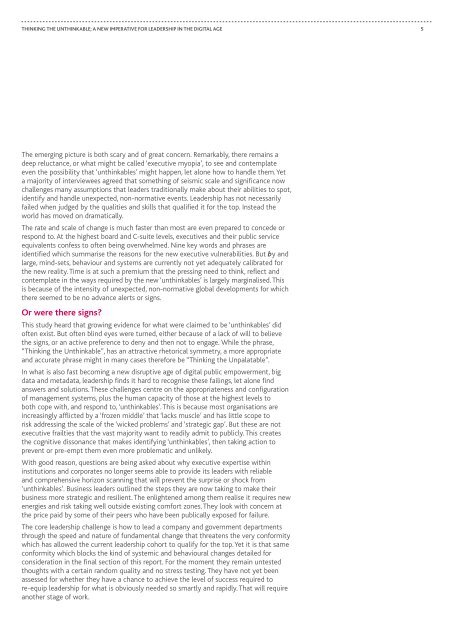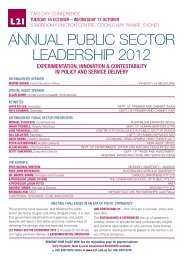Thinking the Unthinkable
Thinking-the-Unthinkable-cima-report
Thinking-the-Unthinkable-cima-report
You also want an ePaper? Increase the reach of your titles
YUMPU automatically turns print PDFs into web optimized ePapers that Google loves.
THINKING THE UNTHINKABLE; A NEW IMPERATIVE FOR LEADERSHIP IN THE DIGITAL AGE<br />
5<br />
The emerging picture is both scary and of great concern. Remarkably, <strong>the</strong>re remains a<br />
deep reluctance, or what might be called ‘executive myopia’, to see and contemplate<br />
even <strong>the</strong> possibility that ‘unthinkables’ might happen, let alone how to handle <strong>the</strong>m. Yet<br />
a majority of interviewees agreed that something of seismic scale and significance now<br />
challenges many assumptions that leaders traditionally make about <strong>the</strong>ir abilities to spot,<br />
identify and handle unexpected, non-normative events. Leadership has not necessarily<br />
failed when judged by <strong>the</strong> qualities and skills that qualified it for <strong>the</strong> top. Instead <strong>the</strong><br />
world has moved on dramatically.<br />
The rate and scale of change is much faster than most are even prepared to concede or<br />
respond to. At <strong>the</strong> highest board and C-suite levels, executives and <strong>the</strong>ir public service<br />
equivalents confess to often being overwhelmed. Nine key words and phrases are<br />
identified which summarise <strong>the</strong> reasons for <strong>the</strong> new executive vulnerabilities. But by and<br />
large, mind-sets, behaviour and systems are currently not yet adequately calibrated for<br />
<strong>the</strong> new reality. Time is at such a premium that <strong>the</strong> pressing need to think, reflect and<br />
contemplate in <strong>the</strong> ways required by <strong>the</strong> new ‘unthinkables’ is largely marginalised. This<br />
is because of <strong>the</strong> intensity of unexpected, non-normative global developments for which<br />
<strong>the</strong>re seemed to be no advance alerts or signs.<br />
Or were <strong>the</strong>re signs?<br />
This study heard that growing evidence for what were claimed to be ‘unthinkables’ did<br />
often exist. But often blind eyes were turned, ei<strong>the</strong>r because of a lack of will to believe<br />
<strong>the</strong> signs, or an active preference to deny and <strong>the</strong>n not to engage. While <strong>the</strong> phrase,<br />
“<strong>Thinking</strong> <strong>the</strong> <strong>Unthinkable</strong>”, has an attractive rhetorical symmetry, a more appropriate<br />
and accurate phrase might in many cases <strong>the</strong>refore be “<strong>Thinking</strong> <strong>the</strong> Unpalatable”.<br />
In what is also fast becoming a new disruptive age of digital public empowerment, big<br />
data and metadata, leadership finds it hard to recognise <strong>the</strong>se failings, let alone find<br />
answers and solutions. These challenges centre on <strong>the</strong> appropriateness and configuration<br />
of management systems, plus <strong>the</strong> human capacity of those at <strong>the</strong> highest levels to<br />
both cope with, and respond to, ‘unthinkables’. This is because most organisations are<br />
increasingly afflicted by a ‘frozen middle’ that ‘lacks muscle’ and has little scope to<br />
risk addressing <strong>the</strong> scale of <strong>the</strong> ‘wicked problems’ and ‘strategic gap’. But <strong>the</strong>se are not<br />
executive frailties that <strong>the</strong> vast majority want to readily admit to publicly. This creates<br />
<strong>the</strong> cognitive dissonance that makes identifying ‘unthinkables’, <strong>the</strong>n taking action to<br />
prevent or pre-empt <strong>the</strong>m even more problematic and unlikely.<br />
With good reason, questions are being asked about why executive expertise within<br />
institutions and corporates no longer seems able to provide its leaders with reliable<br />
and comprehensive horizon scanning that will prevent <strong>the</strong> surprise or shock from<br />
‘unthinkables’. Business leaders outlined <strong>the</strong> steps <strong>the</strong>y are now taking to make <strong>the</strong>ir<br />
business more strategic and resilient. The enlightened among <strong>the</strong>m realise it requires new<br />
energies and risk taking well outside existing comfort zones. They look with concern at<br />
<strong>the</strong> price paid by some of <strong>the</strong>ir peers who have been publically exposed for failure.<br />
The core leadership challenge is how to lead a company and government departments<br />
through <strong>the</strong> speed and nature of fundamental change that threatens <strong>the</strong> very conformity<br />
which has allowed <strong>the</strong> current leadership cohort to qualify for <strong>the</strong> top. Yet it is that same<br />
conformity which blocks <strong>the</strong> kind of systemic and behavioural changes detailed for<br />
consideration in <strong>the</strong> final section of this report. For <strong>the</strong> moment <strong>the</strong>y remain untested<br />
thoughts with a certain random quality and no stress testing. They have not yet been<br />
assessed for whe<strong>the</strong>r <strong>the</strong>y have a chance to achieve <strong>the</strong> level of success required to<br />
re-equip leadership for what is obviously needed so smartly and rapidly. That will require<br />
ano<strong>the</strong>r stage of work.



